Beef Bulgogi
Beef Bulgogi is a traditional Koren entree that features marinated flank steak that’s pan seared to perfection and served with tender veggies. This quick and easy beef dinner is better than any take-out you can order! Serve this supremely flavorful beef over some fluffy rice to round out your meal in the most satisfying way.
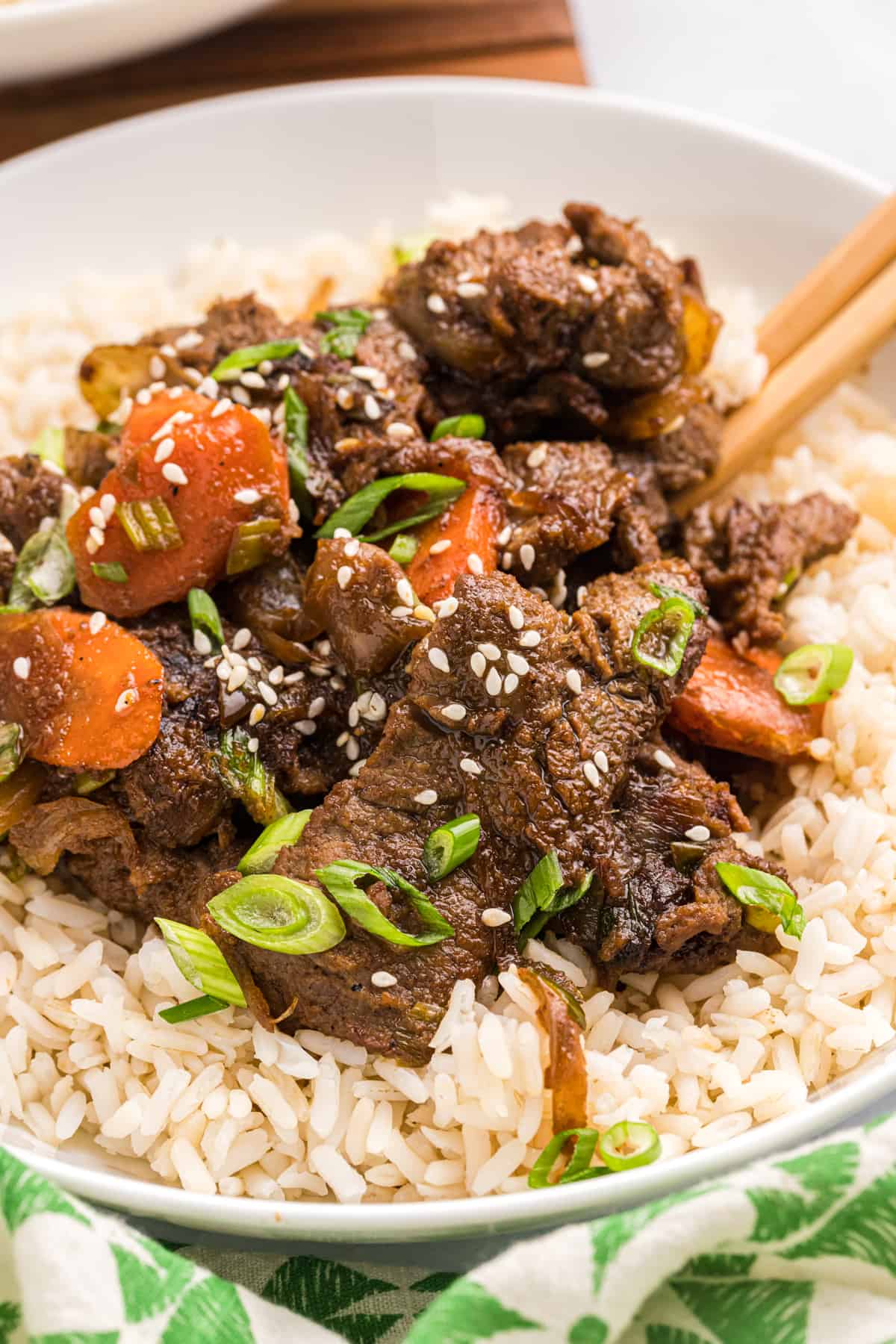
Beef Bulgogi
Put down the phone… And consider deleting all of those food delivery apps! With the amount of extra fees that are tacked on these days, no serving of beef bulgogi is worth the crazy prices you’ll have to pay. That’s just one of the many reasons I prefer making this dish in my own kitchen – it’s so much less expensive than ordering out!
Another huge reason I love making beef bulgogi at home is because it never disappoints. The flavors from the marinade are created with ingredients like soy sauce, brown sugar, rice wine, sesame oil and more, making the beef SO crazy flavor-packed. Also, this dish is very quick and easy to make. In fact, I think I can cook it in my kitchen faster than it could be delivered from a local place.
To make this classic Korean recipe, you simply have to let the meat marinate before pan searing it and the veggies. Serve on top of a bed of rice with some sesame seeds as a garnish and dig in! This meal is great to serve as a weeknight dinner at home with the family or as the main course of a fun dinner party with friends. It’s low-stress and always a huge hit!
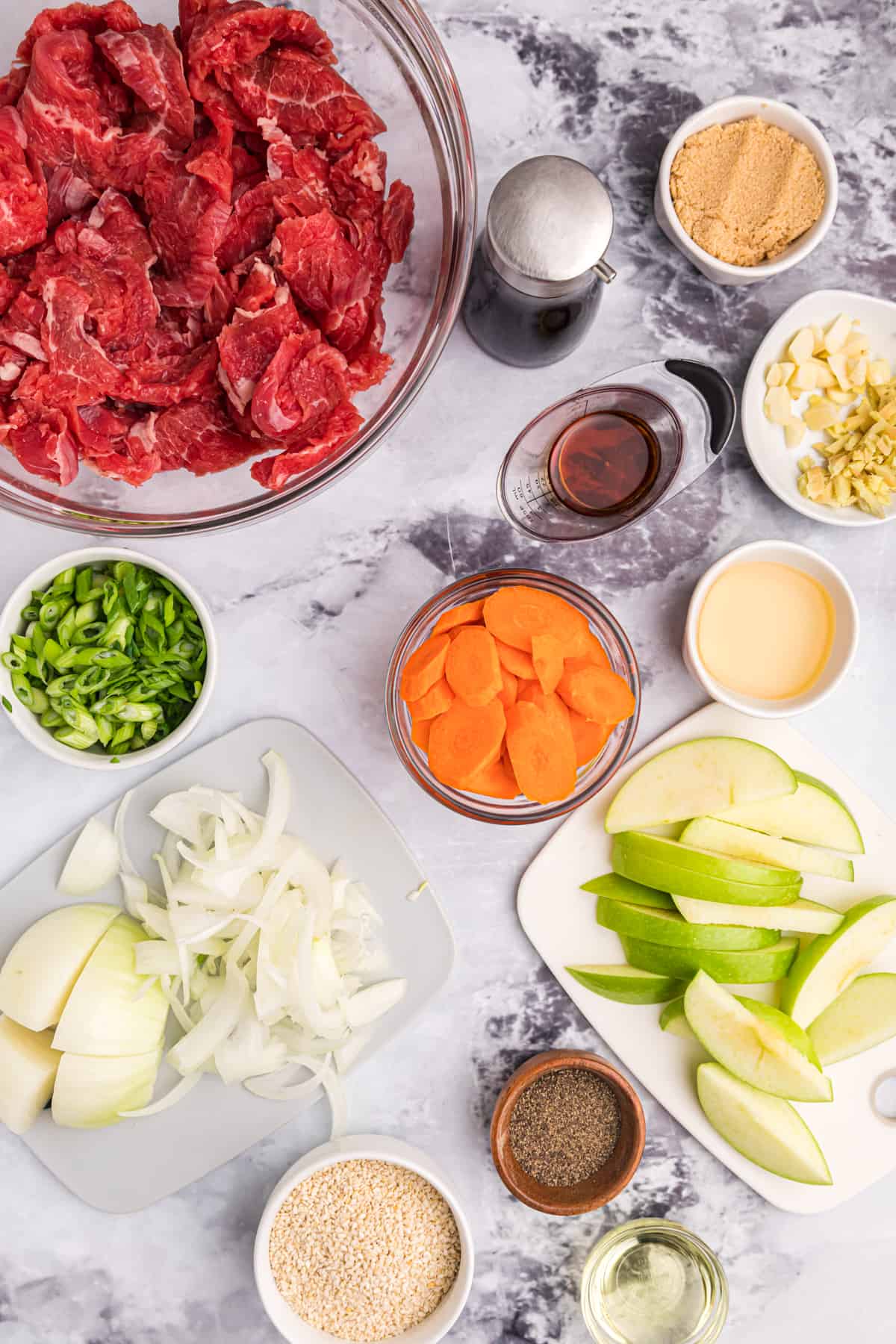
How to Make Beef Bulgogi
- Marinate the meat. Blend all of the ingredients for the marinade until smooth. Place the sliced beef and marinade into a bowl and toss so the meat is covered. Cover with plastic wrap and chill in the fridge for at least 4 hours.
- Cook the meat. Strain the meat from the marinade. Heat the oil in a large skillet over medium-high heat. Working in batches, cook the beef for about 1-2 minutes per side to sear it. Once it’s all cooked, add all of the meat back into the skillet.
- Add the vegetables. Toss the veggies into the pan with the meat and cook for about 3-4 minutes.
Enjoy! Sprinkle the beef bulgogi with sesame seeds and serve immediately. Garnish with chopped green onions and serve over white rice.
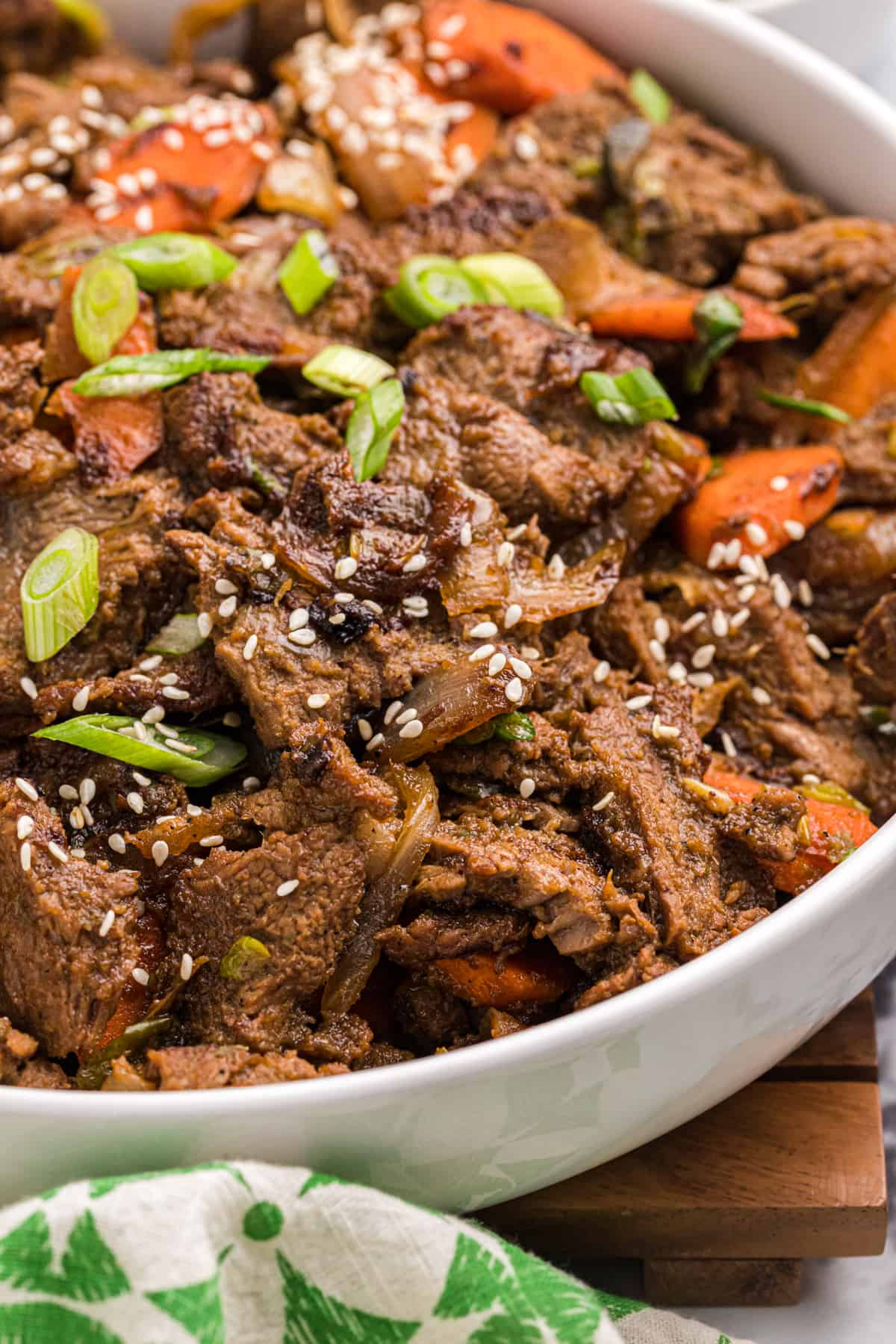
Tips and Variations to Try
- Ribeye can be used instead of flank steak. Keep in mind that more liquid might be produced when cooking ribeye due to its higher fat content.
- Slice the carrots thinly. Since the vegetables are not being blanched in advance, slicing them as thinly as possible will ensure they don’t take a long time to cook through.
- Strain the meat before cooking. If there’s a lot of marinade on the pieces of meat, it will create a thin sauce in the dish while cooking.
- You can make it gluten-free. Make sure to use gluten-free soy sauce, coconut aminos or tamari.
- You can use a wok instead of a cast iron skillet. A wok can be used. You’ll want to make sure you get the skillet very hot when adding each batch of meat to sear the outside of the pieces. Using a skillet that is not cast iron may result in a less caramelized coating on the beef.
Storing and Reheating
Once cooled to room temperature, you can store your leftover beef bulgogi in an airtight container in the fridge for 3-4 days. While you can reheat it in the microwave, it’s even better back in the skillet over medium-low heat!
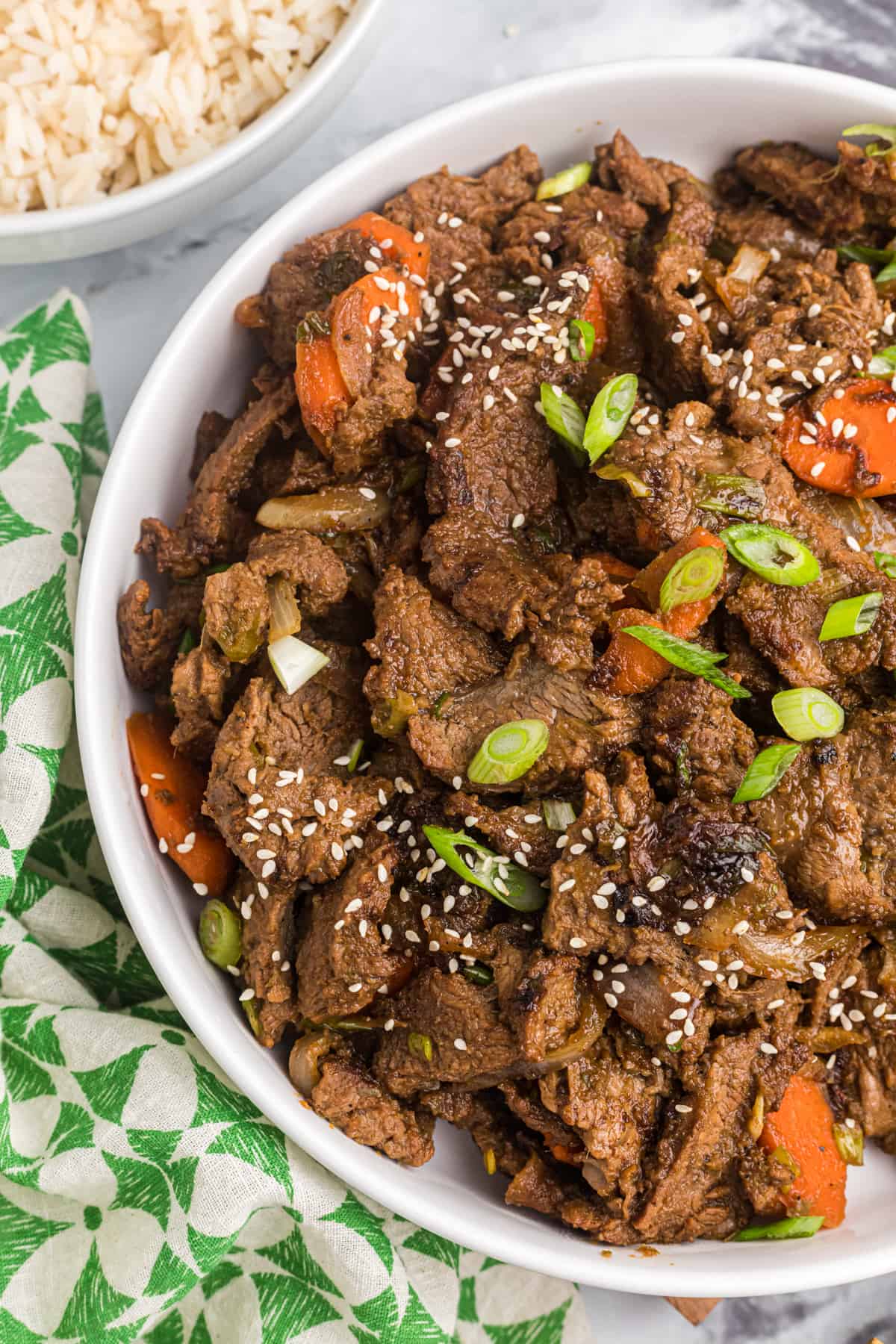
Enjoy more of my favorite beef entrees!
For more easy take out recipes, follow us on Instagram and Facebook!
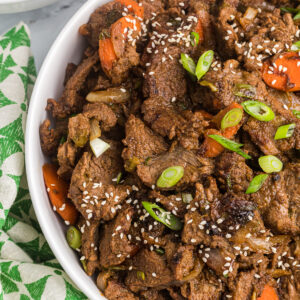
Get the Recipe: Beef Bulgogi Recipe
Ingredients
For the Marinade:
- 1/3 cup soy sauce, low sodium
- 3 Tablespoon brown sugar
- 2 Tablespoon rice wine
- 1 Tablespoon sesame oil
- 1 each Asian pear, peeled, seeded and cut in small cubes (a Granny Smith apple can be subbed if an Asian pear is not available)
- ¼ cup yellow onion, large dice
- 1 Tablespoon garlic, chopped
- 1 teaspoon ginger, chopped
- 1/8 teaspoon black pepper
For the Beef:
- 2 pounds flank steak, sliced very thin
- 1 cup yellow onion, sliced thin
- 1/2 cup green onion, sliced and divided
- ½ cup carrot, peeled and sliced thin on a bias
- 1 Tablespoon vegetable oil
- ½ Tablespoon sesame seeds, toasted
- Fresh green onions, sliced for garnish
Equipment
- 1 skillet
Instructions
- In a blender or food processor blend all the ingredients for the marinade until smooth.
- Place the sliced beef in a bowl and cover with the marinade. Mix the marinade into the meat.
- Cover the bowl with plastic wrap and refrigerate for at least 4 hours or overnight.
- When you are ready to cook the meat, remove it from the marinade into a strainer sitting over a larger bowl. This will allow any additional moisture/marinated to come off the meat and avoid creating a sauce in the cooking pan.
- Heat the oil in a large cast iron skillet on medium high. Add the meat in small batches for 1-2 minutes per side; move the first batches to a small plate while the rest of the marinated beef is being seared. Once the last batch is cooked 1 minute per side, add back all the meat to the cast iron skillet.
- Add all the vegetables and cook, stirring occasionally for about 3-4 more minutes or until vegetables and meat are cooked.
- Sprinkle with sesame seeds and serve at once, garnished with the remaining chopped green onions. Can also be served with fresh steamed white rice.
Notes
- Storage: Leftovers can be refrigerated in an airtight container up to 2 days after being cooked.
- FAQ’s? Can I use Ribeye steak instead? Yes, ribeye can be used instead of flank steak, however more liquid might be produced when cooking the meat due to its higher fat content.
- Why do the carrots have to be cut so thinly? Since the vegetables are not being blanched in advance, slicing them as thinly as possible on the bias/diagonal will ensure they don’t take a long time to cook through.
- Why do I have to drain the meat from the marinade before cooking? If there is a lot of marinade on the pieces of meat, it will create a thin sauce in the dish while cooking.
- Can I add more carrots and onions to this dish? Yes! More veggies can be added if you’re cooking for a crowd, you can also add thinly sliced celery for added texture.
- How can I make this dish gluten free? Make sure to use gluten free soy sauce, commonly named Tamarin sauce- found in the same section of the grocery store as soy sauce would be found.
- Can I use a wok skillet instead of a cast iron skillet? Yes, a different skillet can be used, you’ll want to make sure you get the skillet very hot when adding each batch of meat to sear the outside of the pieces. Using a skillet that is not cast iron may result in a less caramelized coating on the beef.
